A Robust Battery Grouping Method Based on a Characteristic Distribution Model
Abstract
:1. Introduction
2. Related Work
3. The Proposed Battery Grouping Method
3.1. The Discharging Characteristic Curve
3.2. Characteristic Distribution Model
- The batteries grouped into the pack should have more similar characteristics than the others and meet the characteristic consistency criterion.
- For a set of batteries to be grouped, the objective is to maximize the number of successful-grouping battery packs by making full use of the batteries with similar characteristics.
4. Experiment and Discussion
5. Conclusions
Acknowledgments
Author Contributions
Conflicts of Interest
References
- Lee, I.O. A Hybrid PWM-Resonant DC-DC Converter for Electric Vehicle Battery Charger Applications. J. Power Electron. 2015, 15, 1158–1167. [Google Scholar] [CrossRef]
- Liu, T.; Chen, Y.; Yi, P.; Chen, J. Integrated battery charger with power factor correction for electric-propulsion systems. IET Electr. Power Appl. 2015, 9, 229–238. [Google Scholar] [CrossRef]
- Feng, B.; Lin, H.; Wang, X. Modulation and control of ac/dc matrix converter for battery energy storage application. IET Power Electron. 2015, 8, 1583–1594. [Google Scholar] [CrossRef]
- Wang, T.; Tseng, K.J.; Zhao, J.; Wei, Z. Thermal investigation of lithium-ion battery module with different cell arrangement structures and forced air-cooling strategies. Appl. Energy 2014, 134, 229–238. [Google Scholar] [CrossRef]
- Zheng, Y.; Ouyang, M.; Lu, L.; Li, J.; Han, X.; Xu, L. On-line equalization for lithium-ion battery packs based on charging cell voltages: Part 2. Fuzzy logic equalization. J. Power Source 2014, 247, 460–466. [Google Scholar] [CrossRef]
- Li, J.; Michael, S.M. Accurate battery pack modeling for automotive applications. J. Power Source 2013, 237, 215–228. [Google Scholar] [CrossRef]
- Gong, X.; Xiong, R.; Chris Mi, C. Study of the Characteristics of Battery Packs in Electric Vehicles with parallel-Connected Lithium-Ion Battery Cells’. IEEE Trans. Ind. Appl. 2015, 51, 1872–1979. [Google Scholar] [CrossRef]
- He, Z.W.; Gao, M.Y.; Wang, C.; Wang, L.; Liu, Y.Y. Adaptive state of charge estimation for Li-ion batteries based on an unscented Kalman filter with an enhanced battery model. Energies 2013, 6, 4134–4151. [Google Scholar] [CrossRef]
- Lin, H.T.; Liang, T.J.; Chen, S. Estimation of battery state of health using probabilistic neural network. IEEE Trans. Ind. Inform. 2013, 9, 679–685. [Google Scholar] [CrossRef]
- Feng, H.; Jiang, Z.; Xie, F.; Yang, P.; Shi, J.; Chen, L. Automatic Fastener Classification and Defect Detection in Vision-Based Railway Inspection Systems. IEEE Trans. Instrum. Meas. 2014, 63, 877–888. [Google Scholar] [CrossRef]
- Yang, Y.X.; Zha, Z.J.; Gao, M.Y.; He, Z.W. A robust vision inspection system for detecting surface defects of film capacitors. Signal Process. 2016, 124, 54–62. [Google Scholar] [CrossRef]
- Gogoana, R.; Pinson, M.B.; Bazant, M.Z.; Sarma, S.E. Internal Resistance Matching for Parallel-connected Lithium-ion Cells and Impacts on Battery Pack Cycle Life. J. Power Source 2014, 252, 8–13. [Google Scholar] [CrossRef]
- David, R.P.; Edward, P.D.; Michael, F.; Stimson, E.; Mollendorf, J.C. A rechargeable lithium-ion battery module for underwater use. J. Power Source 2011, 196, 793–800. [Google Scholar]
- Zeng, Y.; Yang, Y.X.; He, Z.W.; Gao, M.Y.; Hong, M. Lead-acid Battery Automatic Grouping System Based on Graph Cuts. Electr. Power Compon. Syst. 2016, 44, 450–458. [Google Scholar] [CrossRef]
- He, Z.W.; Gao, M.Y.; Ma, G.J.; Liu, Y.Y.; Tang, L.J. Battery Grouping with Time Series Clustering Based on Affinity Propagation. Energies 2016, 9, 561. [Google Scholar] [CrossRef]
- Jain, A.; Murty, M.; Flynn, P. Data clustering: A Review. ACM Comput. Surv. 1999, 31, 264–323. [Google Scholar] [CrossRef]
- Li, X.; Nong, Y. A supervised clustering and classification algorithm for mining data with mixed variables. IEEE Trans. Syst. Man Cybern. Part A Syst. Hum. 2006, 36, 396–406. [Google Scholar]
- Tang, H.; Chu, S.M.; Hasegawa-Johnson, M.; Huang, T. Partially Supervised Speaker Clustering. IEEE Trans. Pattern Anal. Mach. Intell. 2014, 34, 959–971. [Google Scholar] [CrossRef] [PubMed]
- Papapetrou, O.; Siberski, W.; Fuhr, N. Decentralized Probabilistic Text Clustering. IEEE Trans. Knowl. Data Eng. 2012, 24, 1848–1861. [Google Scholar] [CrossRef]
- Sulaiman, S.N.; Isa, N. Adaptive fuzzy-K-means clustering algorithm for image segmentation. IEEE Trans. Consum. Electron. 2010, 56, 2661–2668. [Google Scholar] [CrossRef]
- Von Luxburg, U. A tutorial on spectral clustering. Stat. Comput. 2007, 17, 395–416. [Google Scholar] [CrossRef]
- Yang, P.; Zhu, Q.; Huang, B. Spectral clustering with density sensitive similarity function. Knowl. Based Syst. 2011, 24, 621–628. [Google Scholar] [CrossRef]
- Zbib, H.; Mouysset, S.; Stute, S. Unsupervised Spectral Clustering for Segmentation of Dynamic PET Images. IEEE Trans. Nucl. Sci. 2013, 62, 840–850. [Google Scholar] [CrossRef]
- Li, X.; Hu, W.; Shen, C.; Dick, A.; Zhang, Z. Context-Aware Hyper graph Construction for Robust Spectral Clustering. IEEE Trans. Knowl. Data Eng. 2014, 26, 2588–2597. [Google Scholar] [CrossRef]
- Cai, D.; Chen, X. Large Scale Spectral Clustering Via Landmark-Based Sparse Representation. IEEE Trans. Cybern. 2015, 45, 1669–1680. [Google Scholar] [PubMed]
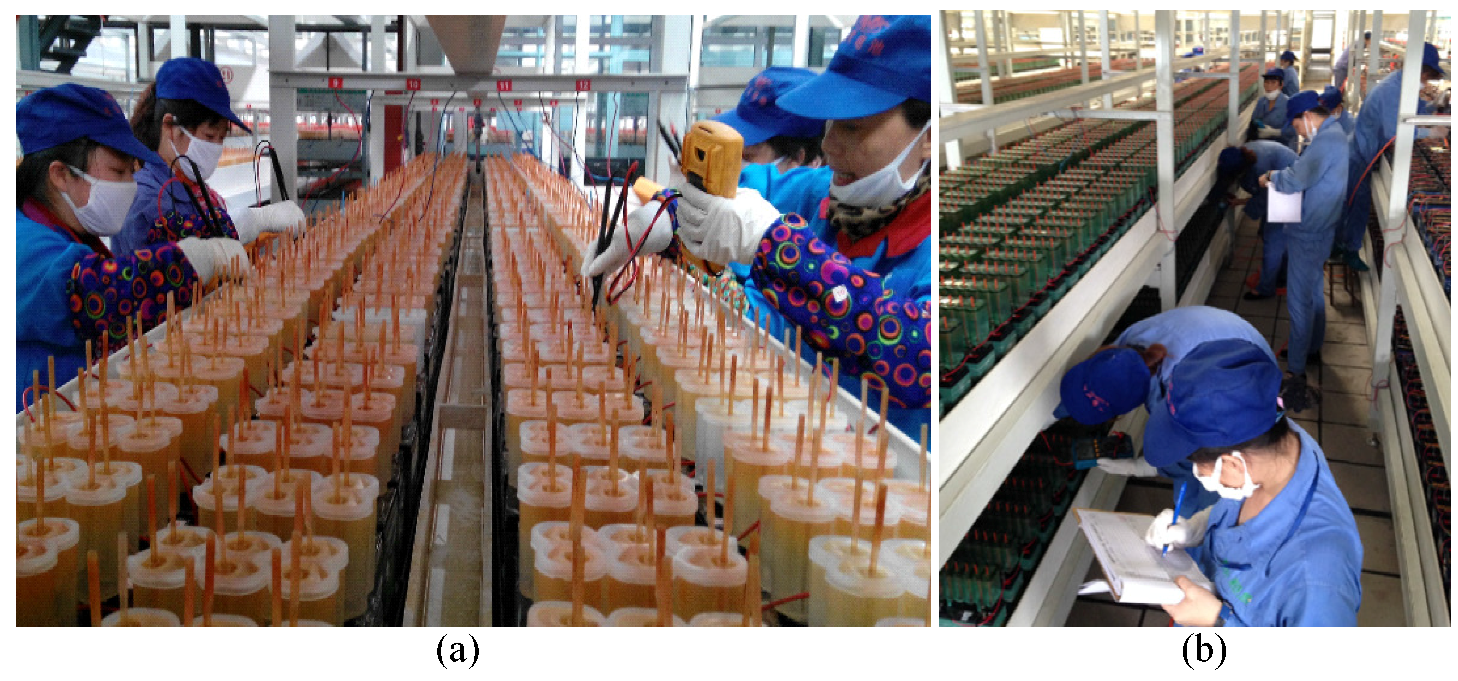

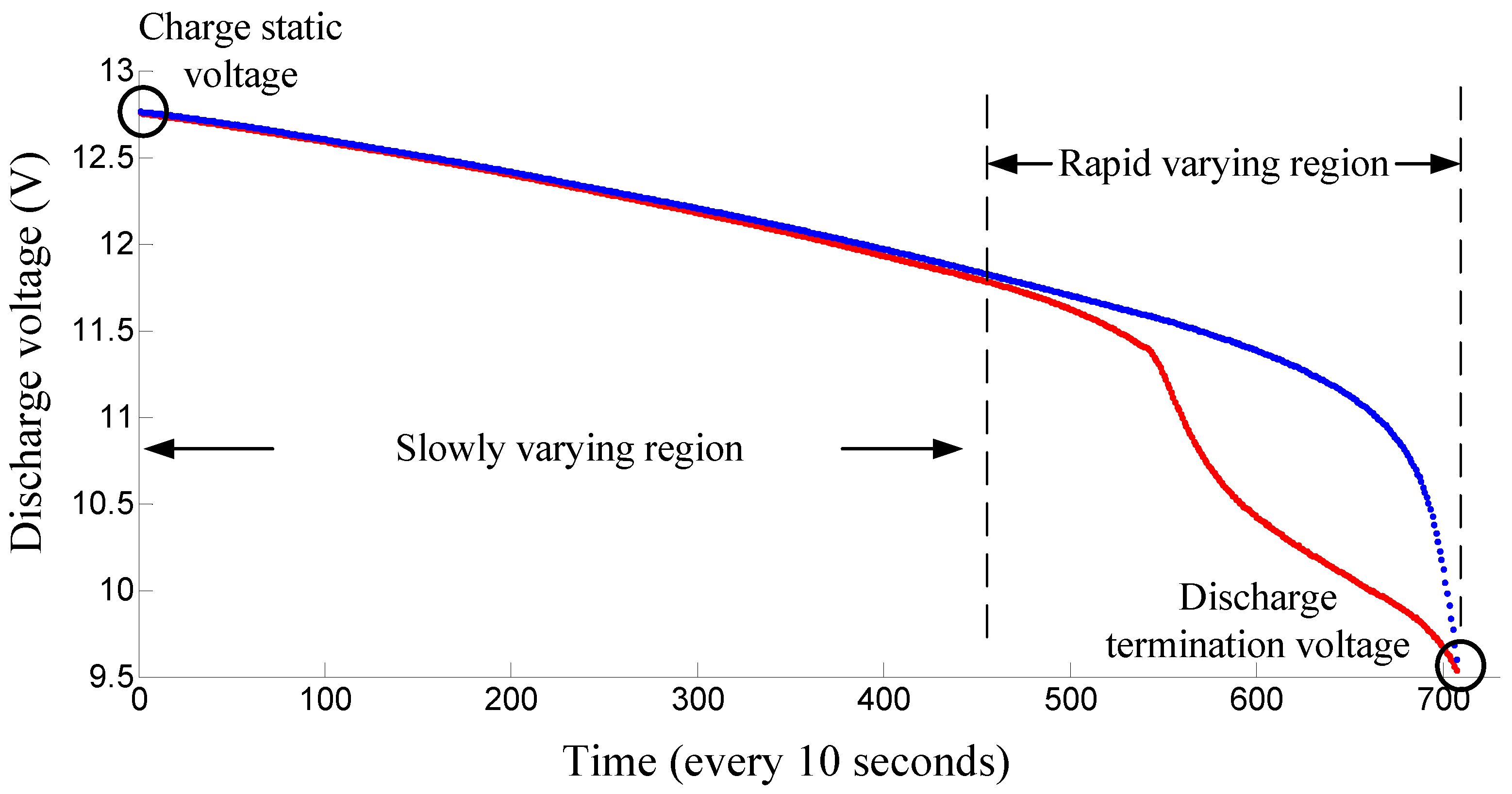
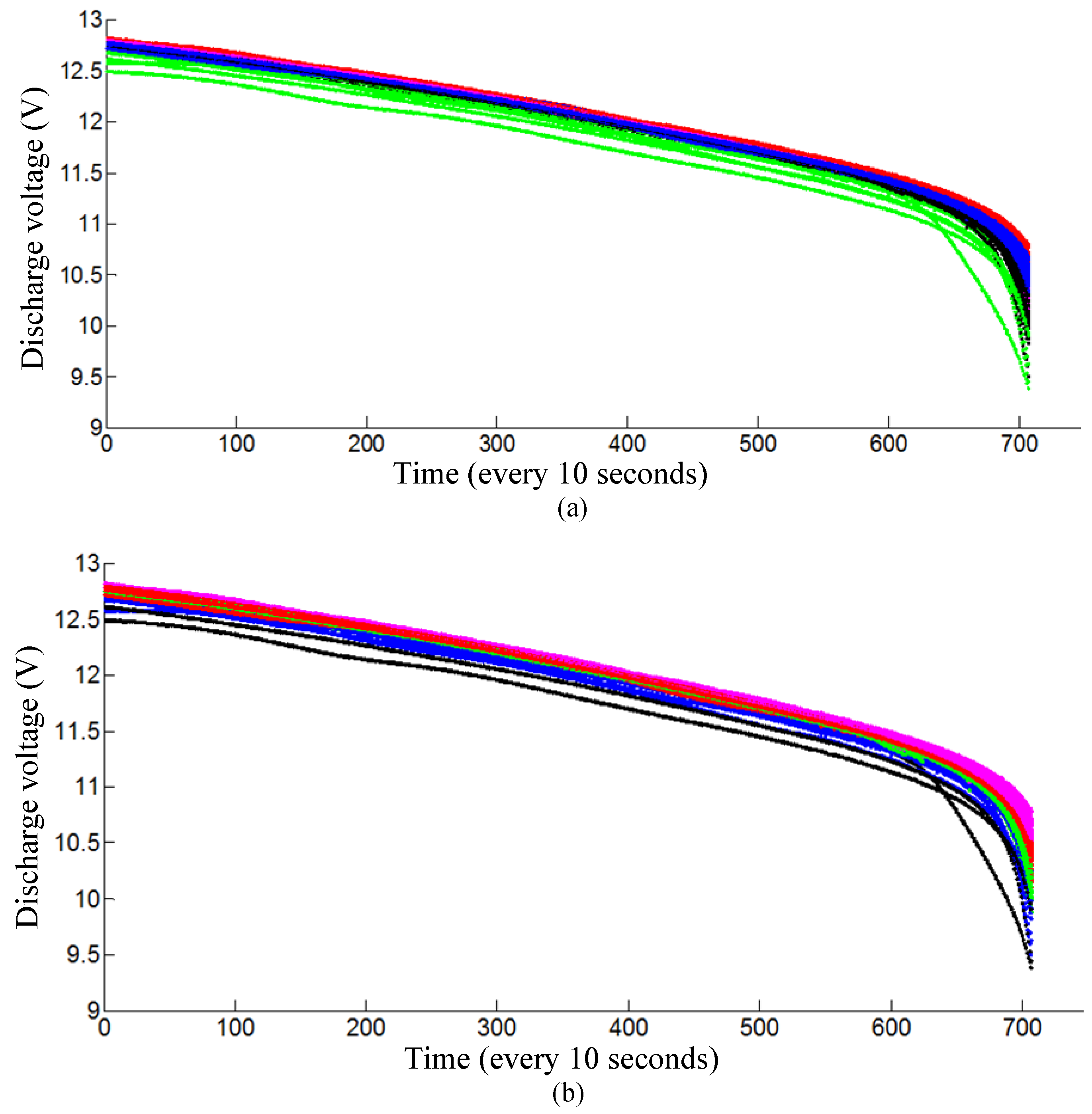
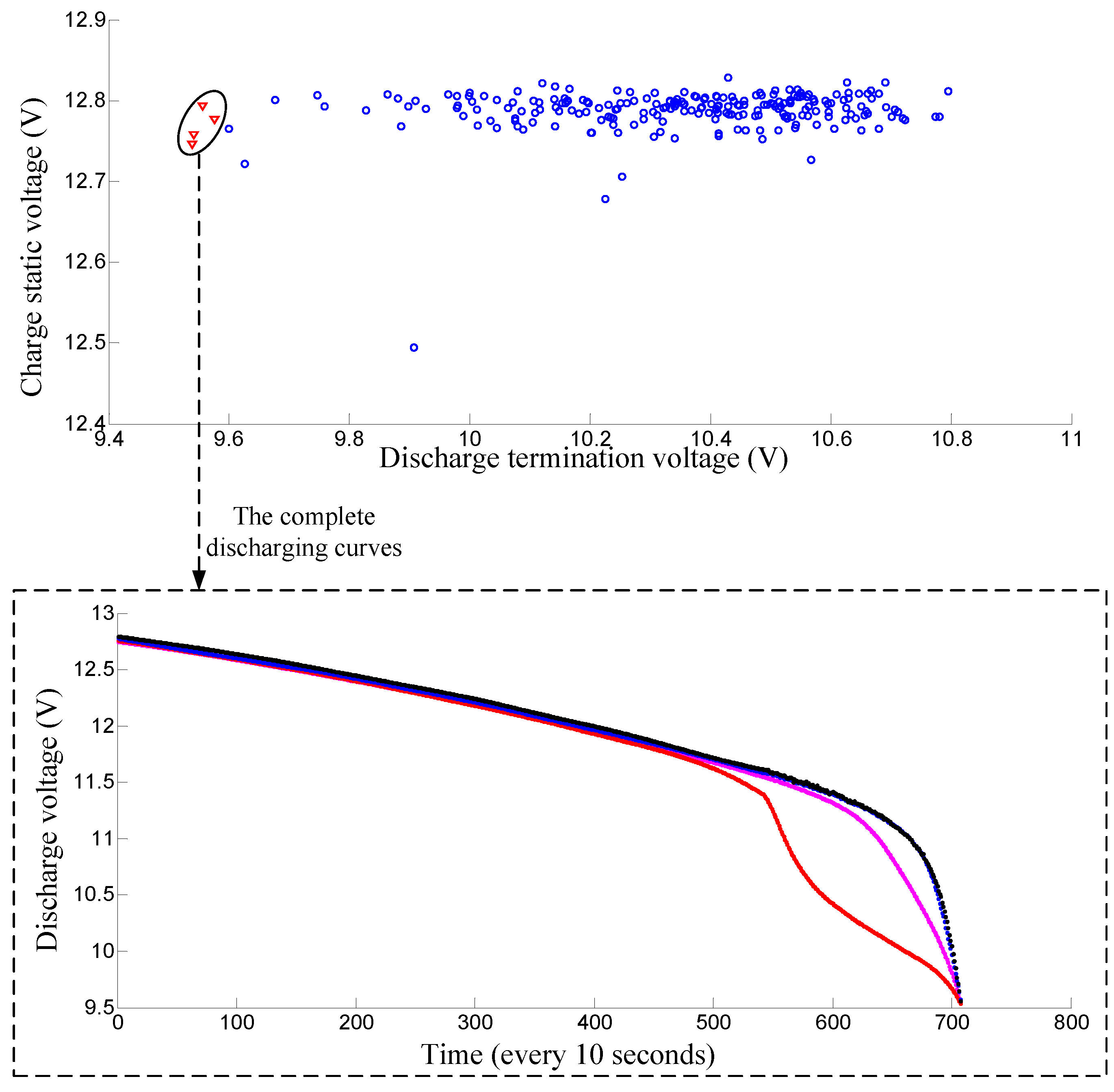
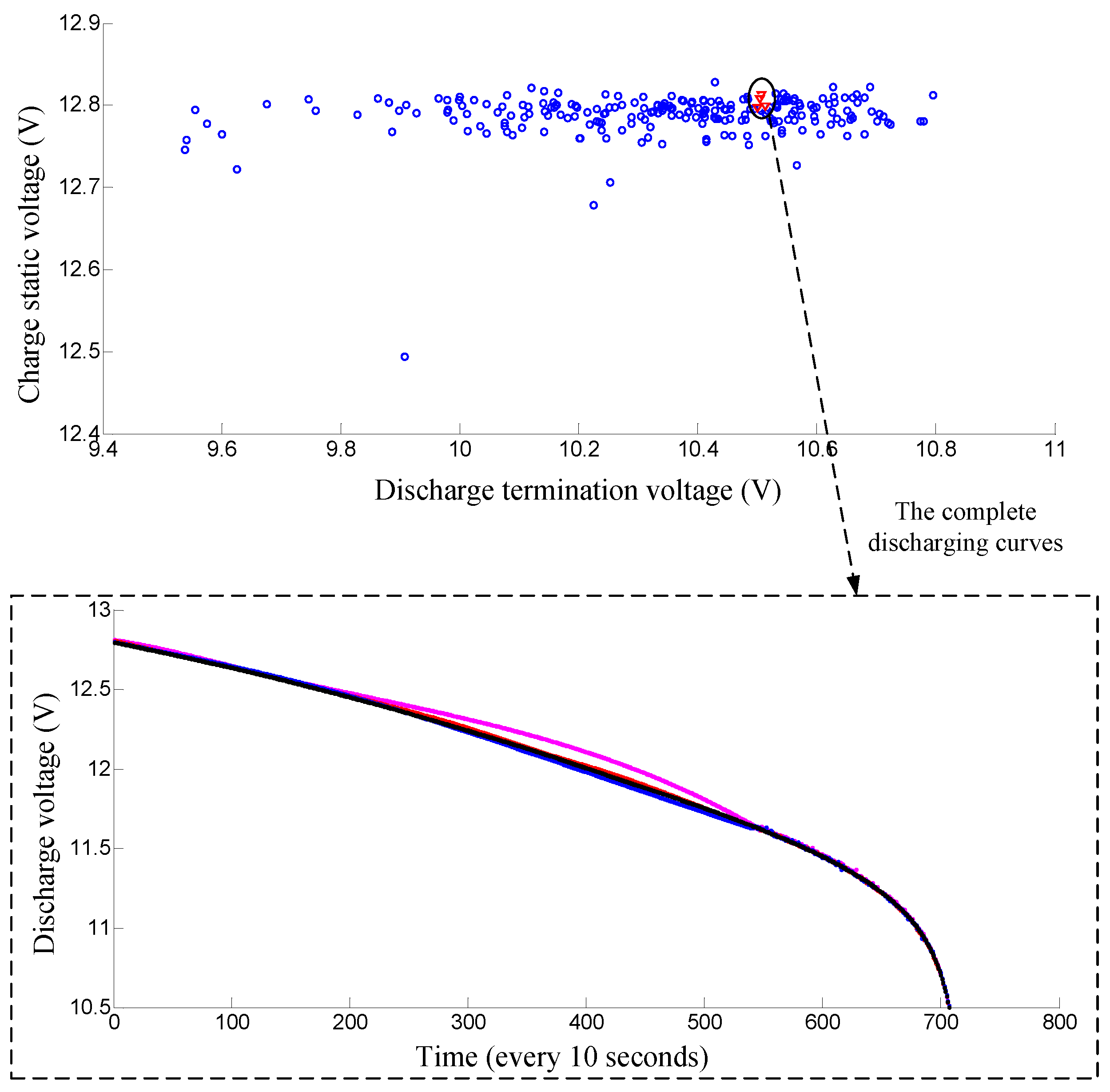

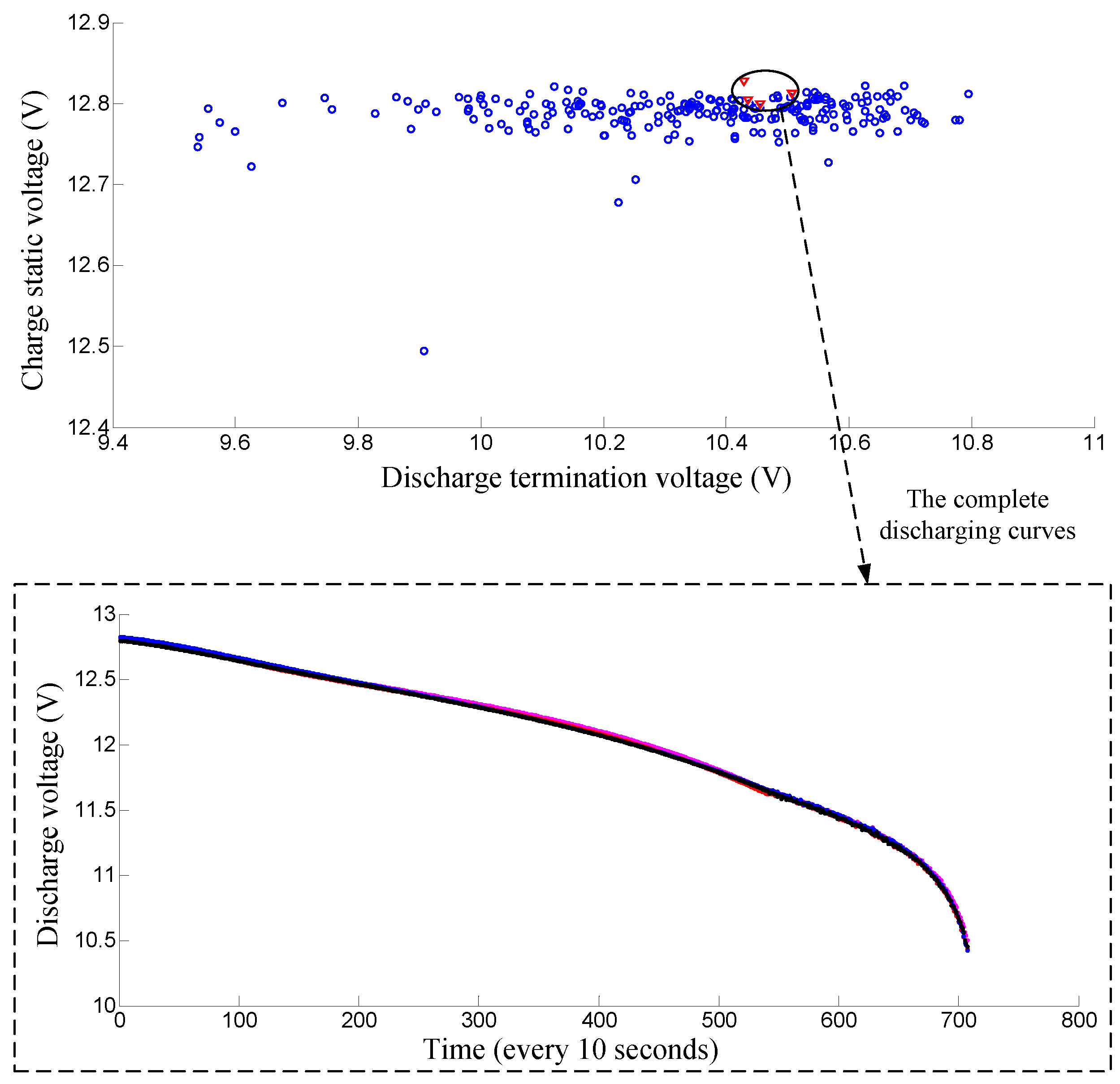
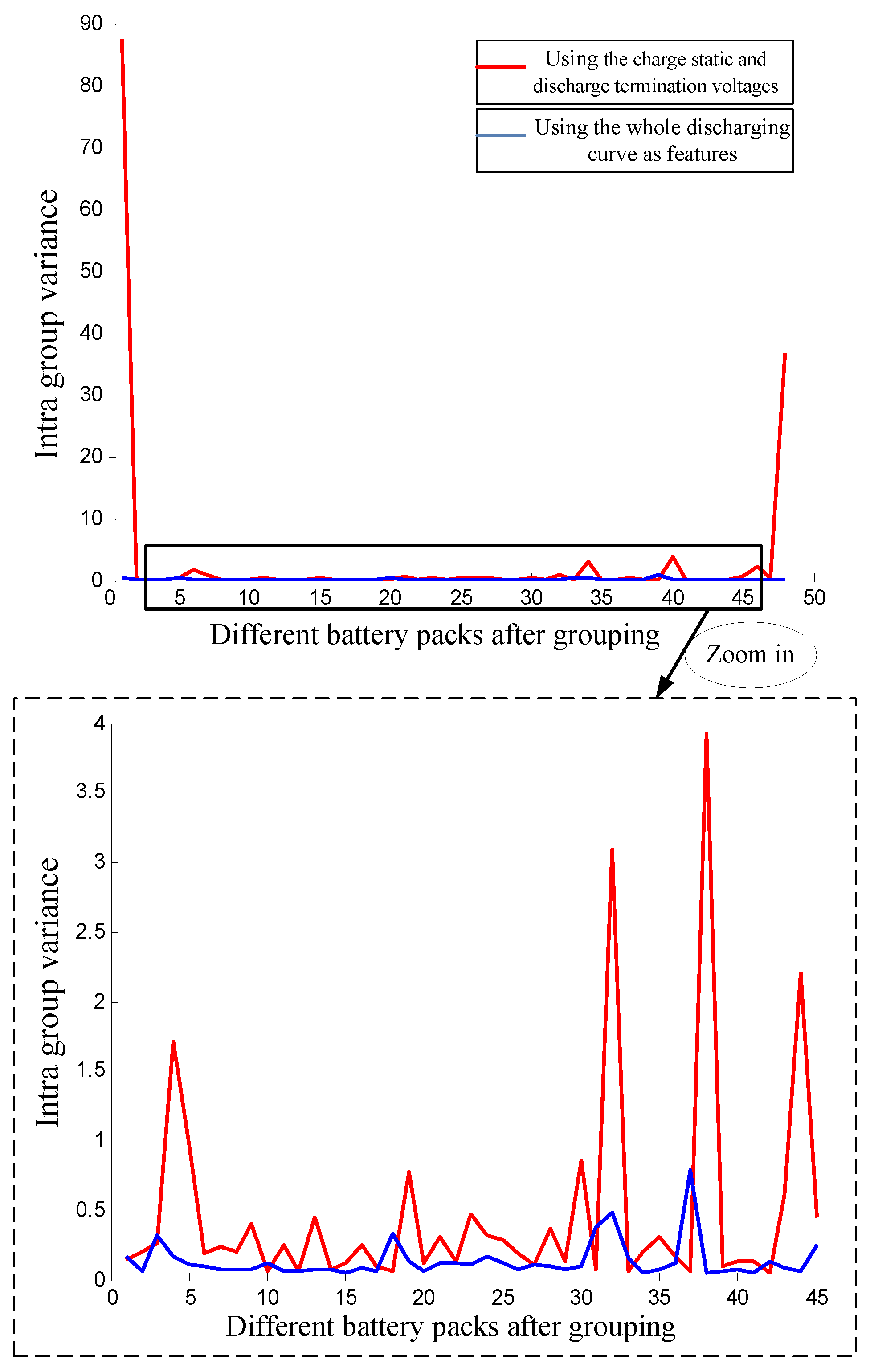
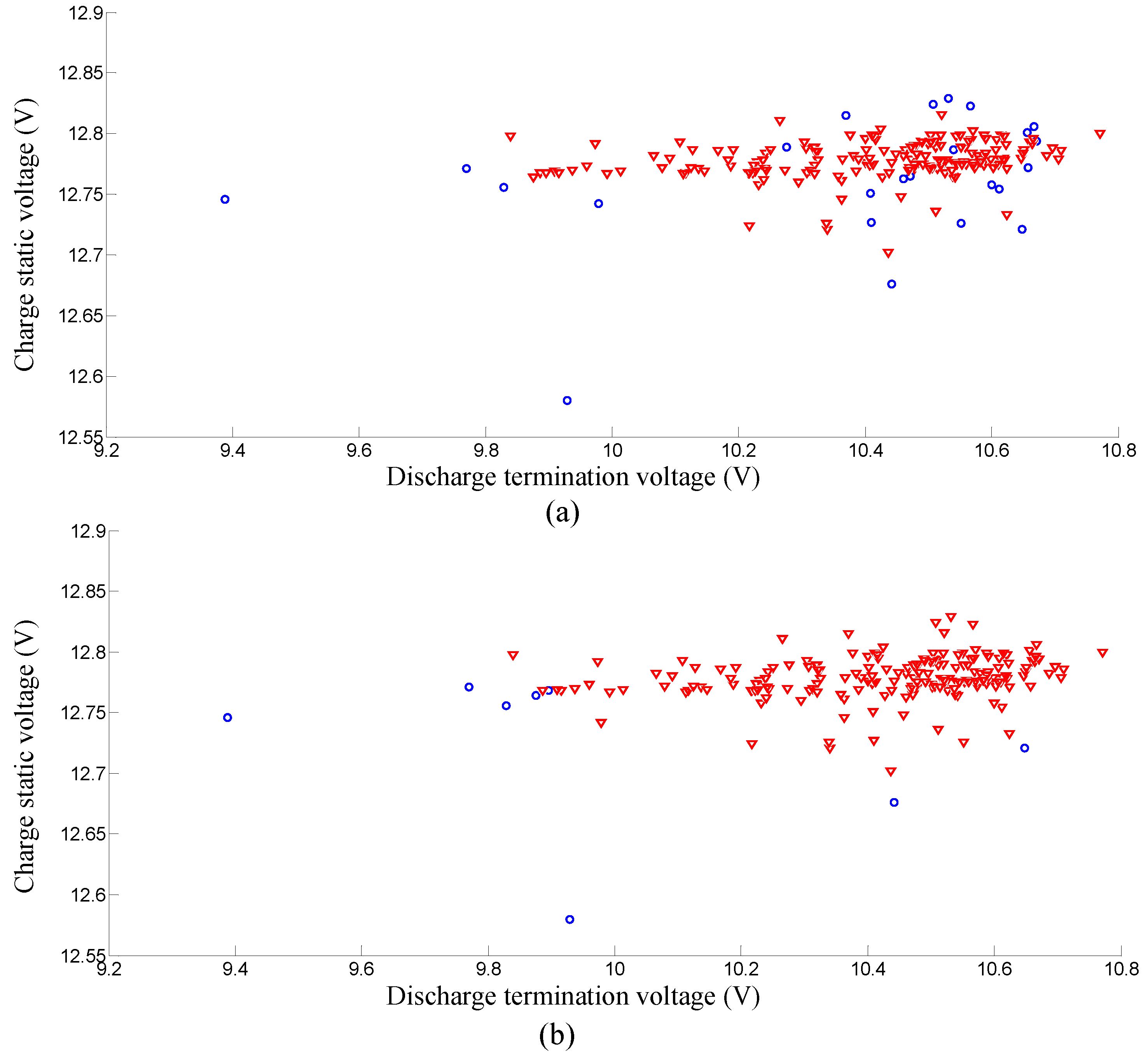
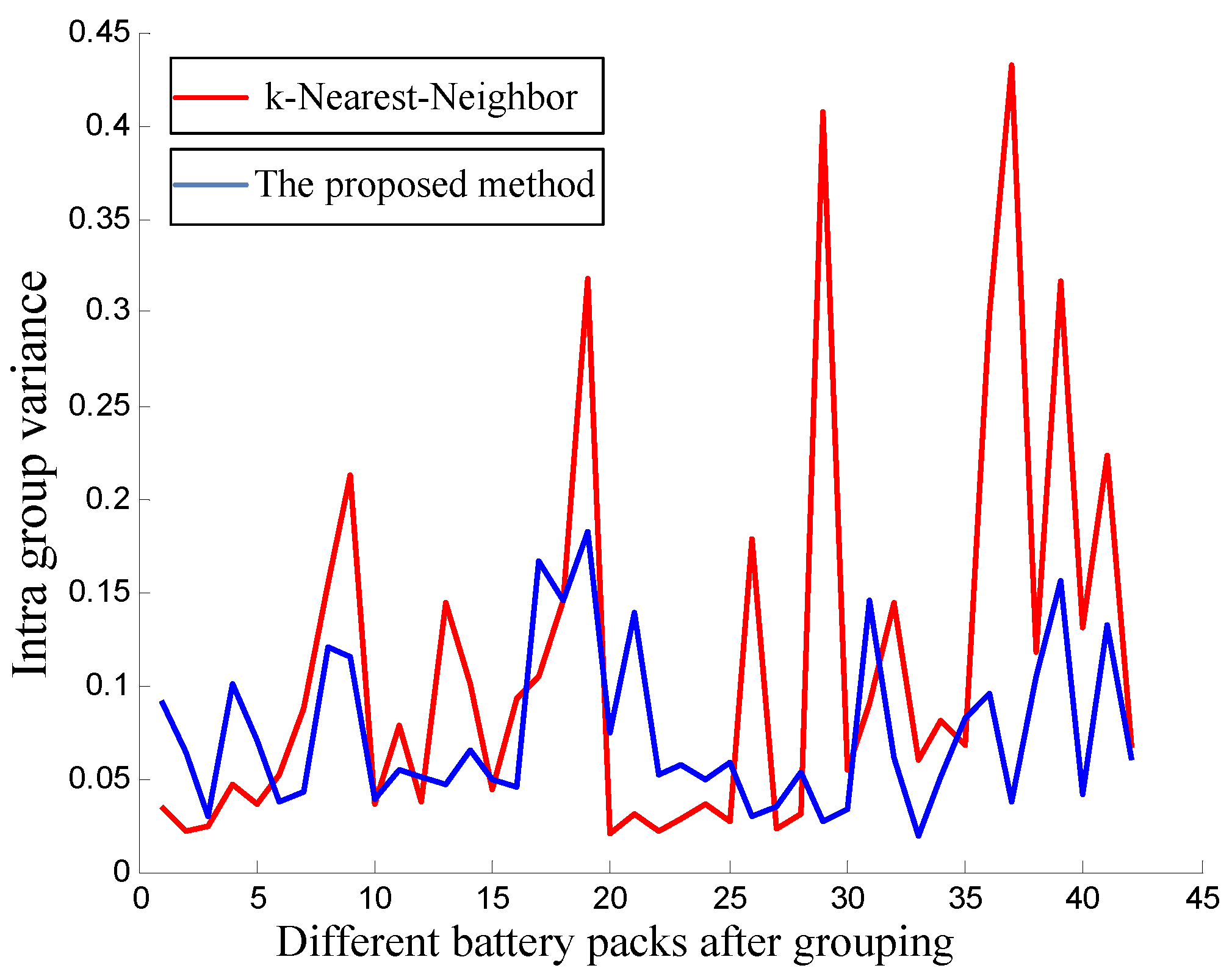
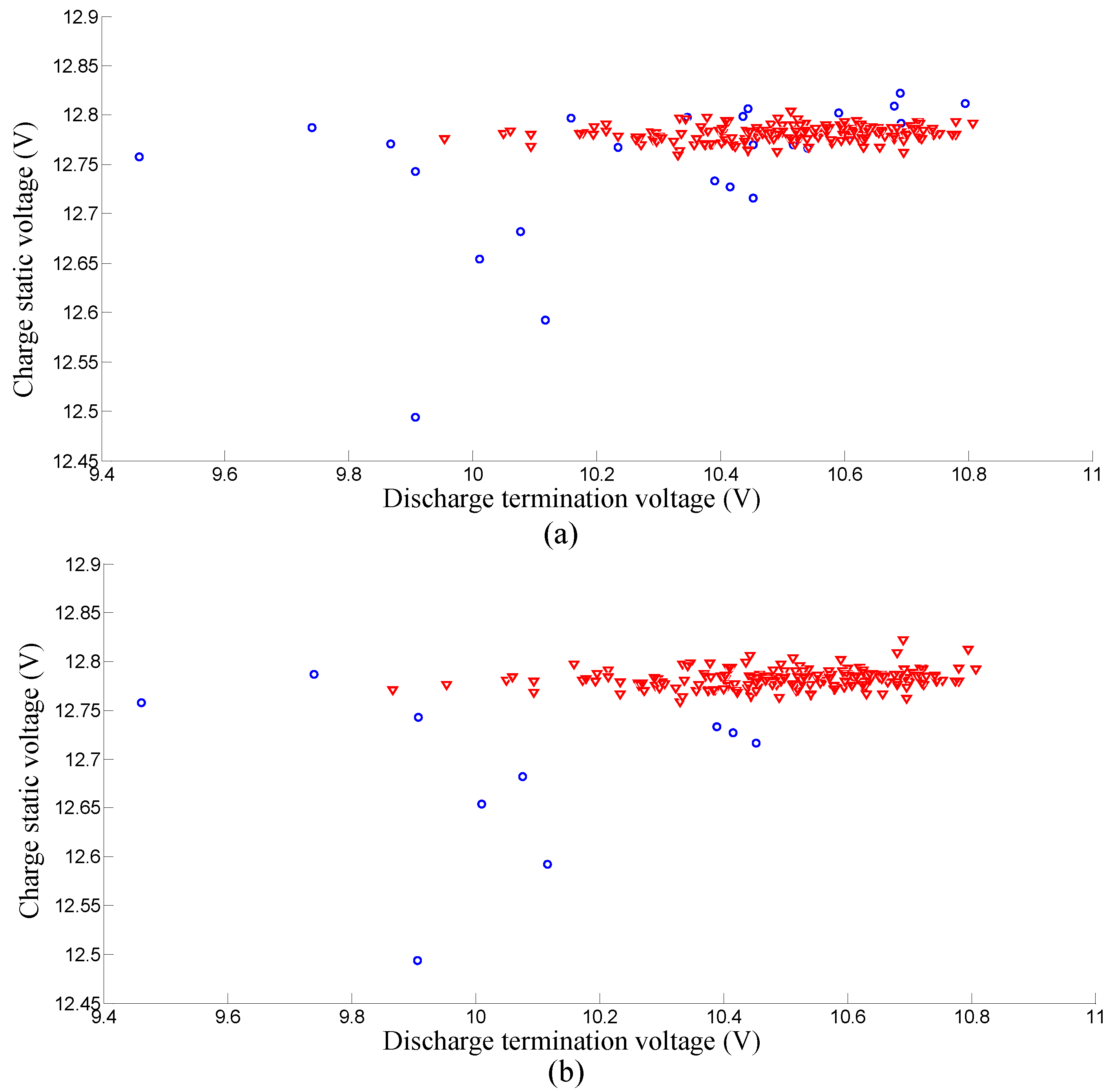
| Features | Maximum Intra-Group Variance | Average Intra-Group Variance |
|---|---|---|
| Only using charge static and discharge termination voltages: | 87.4430 | 2.5986 |
| Using the whole discharge curves: | 0.7948 | 0.1389 |
| Methods | Shelf 1 | Shelf 2 | Shelf 3 | Shelf 4 | Shelf 5 |
|---|---|---|---|---|---|
| “orphan” battery amount of k-nearest-neighbor: | 20 | 24 | 16 | 12 | 12 |
| “orphan” battery amount of the proposed algorithm: | 12 | 8 | 8 | 8 | 4 |
| Average intra-group variance of k-nearest-neighbor: | 0.1423 | 0.1255 | 0.0778 | 0.1239 | 0.1319 |
| Average intra-group variance of the proposed algorithm: | 0.1389 | 0.1003 | 0.0607 | 0.0993 | 0.0936 |
| Methods | Time Cost of Each Shelf | Time Cost Each Day |
|---|---|---|
| Manual method: | 30 min per shelf | 25 h each day |
| Proposed system: | 2 s per shelf | 100 s each day |
© 2017 by the authors. Licensee MDPI, Basel, Switzerland. This article is an open access article distributed under the terms and conditions of the Creative Commons Attribution (CC BY) license (http://creativecommons.org/licenses/by/4.0/).
Share and Cite
Yang, Y.; Gao, M.; He, Z.; Wang, C. A Robust Battery Grouping Method Based on a Characteristic Distribution Model. Energies 2017, 10, 1035. https://doi.org/10.3390/en10071035
Yang Y, Gao M, He Z, Wang C. A Robust Battery Grouping Method Based on a Characteristic Distribution Model. Energies. 2017; 10(7):1035. https://doi.org/10.3390/en10071035
Chicago/Turabian StyleYang, Yuxiang, Mingyu Gao, Zhiwei He, and Caisheng Wang. 2017. "A Robust Battery Grouping Method Based on a Characteristic Distribution Model" Energies 10, no. 7: 1035. https://doi.org/10.3390/en10071035





